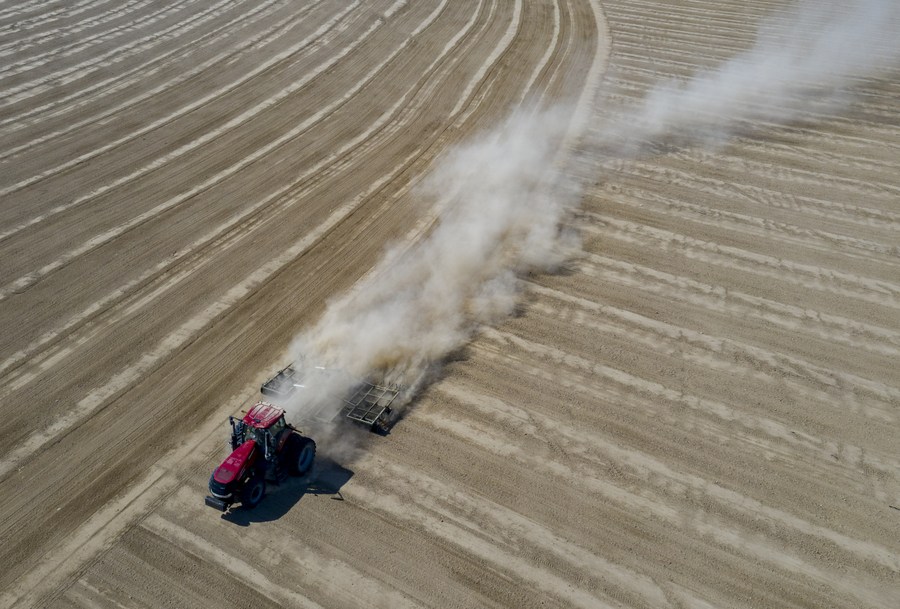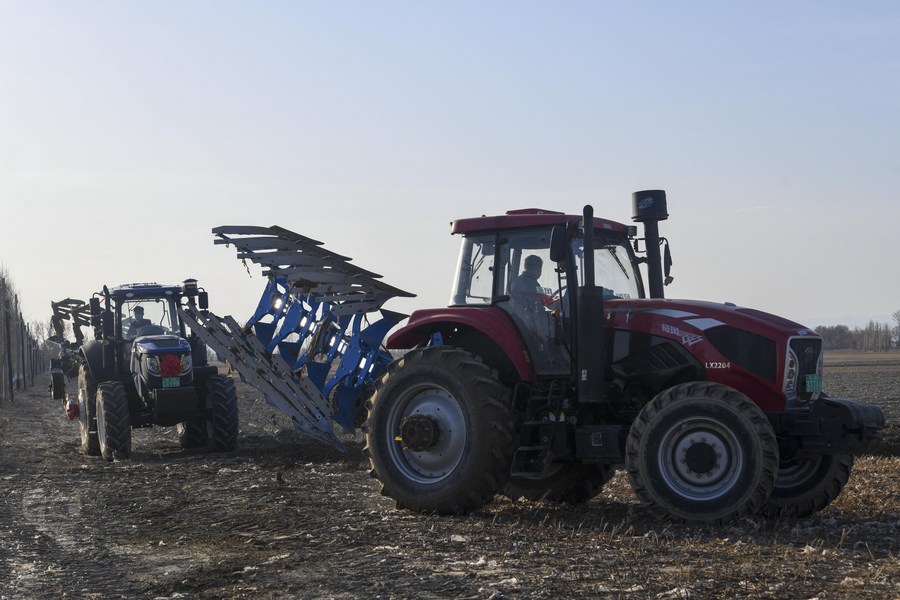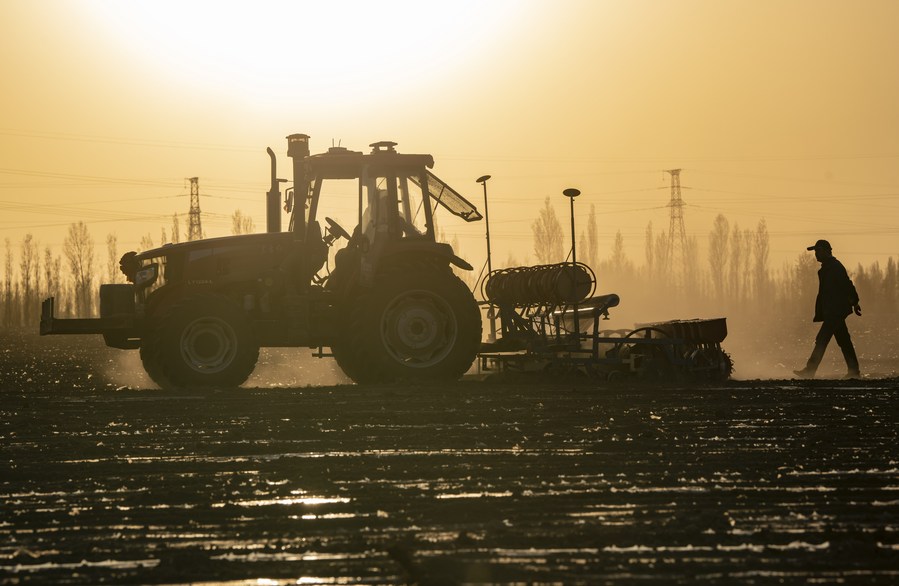* In defiance of economic bullying and vehement defamation by the United States against Xinjiang cotton, farmers there continue cultivating this crop and sowing the seeds for better lives across the region.
* There will be 37.57 million mu of cotton plantation areas in Xinjiang in 2022, increasing 2 percent compared to 2021.
* Cotton sowing is nearly 100 percent mechanized in Xinjiang. In terms of harvesting, machines accounted for over 80 percent of all the work in the region in 2021.

Aerial photo taken on April 16, 2022 shows a tractor working in a cotton field in Daquan of Shawan City, northwest China's Xinjiang Uygur Autonomous Region. (Xinhua/Hu Huhu)
by Xinhua writers Sun Zhennan, Gao Han, Zhao Ge
URUMQI, April 17 (Xinhua) -- The rumbling of tractors busy in the field on both sides of the Tianshan Mountains signals that cotton sowing is in full swing in Xinjiang Uygur Autonomous Region, northwest China.
Jumay Hasan, of Uygur ethnicity, has planted cotton in Shaya County, Aksu Prefecture, for eight years. This year he plans to expand his plantation by 10 mu, meaning he will plant 130 mu (about 8.7 hectares) of cotton.
"I earned 2,000 yuan (about 314 U.S. dollars) in profit from each mu last year," he said. "If things go well, I can get at least 20,000 yuan more this year."
Jumay Hasan is just one of the countless farmers in the region who, in defiance of economic bullying and vehement defamation by the United States against Xinjiang cotton, continue cultivating this crop and sowing the seeds for better lives across the region.

Tractors plow in a cotton field in Shiqiao Township of Usu City, northwest China's Xinjiang Uygur Autonomous Region, March 31, 2022. (Xinhua/Zhao Ge)
UNFAZED AND CONFIDENT
Despite U.S. sanctions on Xinjiang's cotton, Jumay Hasan is confident, and for a good reason. Shaya's high-quality cotton has an excellent reputation, earning it the accolade of the "hometown of cotton in China's Tarim Basin."
Jumay Hasan's buoyancy on the crop is not isolated. Another Uygur farmer, Imin Anayet, who is also from Shaya, makes 2.5 million yuan a year from planting cotton. He also runs a farmers' cooperative, with 10,000 mu of contracted land, providing jobs for over 230 local farmers.
According to estimates from the China Cotton Association, there will be 37.57 million mu of cotton plantation areas in Xinjiang in 2022, increasing 2 percent compared to 2021.
Data released by the National Bureau of Statistics showed that cotton output in Xinjiang topped 5.1 million tonnes last year, accounting for 89.5 percent of the country's total cotton output. Moreover, the region has ranked first in China for more than 20 years in total cotton output, per-unit yield, planting area, and commodity allocation.
"Xinjiang has unique natural conditions, abundant sunshine, and a long cotton growth cycle. It is not only the largest high-quality cotton production base in China but also globally significant," said Peng Changming, vice president of Xinjiang Cotton Association.

An autopilot tractor works in a cotton field in Sangongdian Village of Ulan Usu Township in Shawan City, northwest China's Xinjiang Uygur Autonomous Region, April 16, 2022. (Xinhua/Hu Huhu)
ALL MACHINES, NO FORCED LABOR
Regarding the groundless accusations from the United States, such as "forced labor," Jumay Hasan said, "How could it be possible? From plowing to harrowing, sowing to harvesting, it is nearly all done by machines." This year, he completed all his field work of sowing within five days, an impossible achievement had these tasks been completed manually.
Abdugani Abdukeyum, a Uygur farmer in Bachu County, Kashgar Prefecture, said, "We use a seeding machine guided by the BeiDou Navigation Satellite System to sow, which works precisely and efficiently."
According to a report released by the Institute for Communication and Borderland Governance of Jinan University last year, cotton sowing is nearly 100 percent mechanized in Xinjiang.
Moreover, in terms of harvesting, machines accounted for over 80 percent of all the work in the region in 2021, said the Department of Agriculture and Rural Affairs of Xinjiang.
Muhtar Rohman, a Uygur agricultural machinery operator in Shaya, has witnessed the cotton industry's transformation from manual to mechanical firsthand.
"I watched my parents toil on the field when I was young, and I remember wishing 'if only I had a machine to help them'," he said. In April 2021, he finally made his dream come true. Using the new cotton-picking machine, he helps farmers with their harvesting and now earns more than 100,000 yuan a year.

Photo taken on April 16, 2022 shows a navigational autopilot equipment in a cotton field in Daquan of Shawan City, northwest China's Xinjiang Uygur Autonomous Region. (Xinhua/Hu Huhu)
COTTON BRINGS HAPPINESS
The high mechanization rate has been propelled by the acceleration of large-scale cotton production regionally, which in turn has been driven by the expansion of farmers' cooperatives.
By the end of 2019, Xinjiang was home to 26,424 farmers' cooperatives. According to the region's department of agriculture and rural affairs, on average, 2,000 new cooperatives were established every year from 2010 to 2019.
Yelikat Kalimukan, a Kazak cotton farmer in Shiqiao Township, Usu City, said that the cooperative in his town helped him cut costs.
"Our cooperative provides free high-quality seeds and affordable agricultural materials, helping us save around 80 to 100 yuan on each mu. This helps increase earnings for us small households," Yelikat Kalimukan said.
Since joining a cooperative in 2020, Jumay Hasan says the technical expertise and mechanical services have paid off in dividends.
"Last year, the yield per mu of our cooperative was 410 kilograms, and I earned 240,000 yuan totally," Jumay Hasan said. "Cotton brings us fortune and happiness!"
(Video reporters: Aman, Gao Han, Sun Zhennan, Zhao Ge; video editors: Jia Xiaotong, Mu Xuyao) ■



